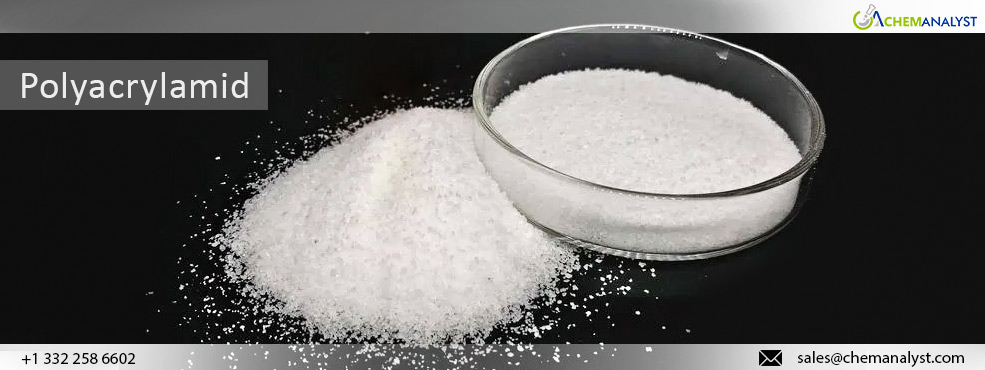Global Polyacrylamide (PAM) Market Dynamics: Price Decline Amidst Varied Demand Trends
- 15-May-2024 2:47 PM
- Journalist: Robert Hume
The global Polyacrylamide (PAM) market is navigating through a complex landscape characterized by divergent demand trends, logistical challenges, and cautious market sentiments. While certain regions experience pricing declines amidst steady demand, others grapple with uncertainties surrounding future demand trajectories during April 2024. Amidst these challenges, distributors in the PAM market remain vigilant, adapting strategies to mitigate risks and capitalize on emerging opportunities within the evolving industrial landscape.
In recent developments within the global PAM market, contrasting trends have emerged, reflecting a nuanced landscape influenced by supply, demand, and external factors. Notably, the Chinese market has experienced a notable decline in PAM prices during April 2024, attributed to a combination of increased inventories and waning demand sentiments. This trend stands in stark contrast to the 6.1% increase observed in China's industrial output during the first quarter of 2024, suggesting a disconnect between upstream and downstream sectors within the industrial sphere.
Meanwhile, pricing dynamics of PAM in Germany have remained relatively stagnant, indicating a steady demand pattern. However, concerns loom regarding future demand trajectories, casting a shadow of uncertainty over market outlooks. Traders, cognizant of these uncertainties, have opted to offload inventories at discounted rates, as the absence of a discernible downtick in global demand persists. Moreover, logistical challenges have emerged in Northern Europe, particularly at key terminals such as Bremerhaven and Rotterdam, where congestion issues have arisen due to adverse weather conditions, port closures, and scheduling conflicts. Despite these challenges, these ports have maintained healthy operational outcomes, providing a silver lining amidst broader logistical hurdles faced by the region. This steadfast demand underscores the indispensable role of PAM in various industrial applications, including textile manufacturing and water treatment processes. Despite market fluctuations, consistent interest from these key sectors continues to underpin the stability and resilience of the PAM market.
However, the pricing landscape of PAM in the USA has witnessed a decline, reflective of steady demand within the region. Nonetheless, concerns persist regarding future demand trends, as global markets show no signs of improvement. This has prompted traders to adjust prices downwards in a bid to clear inventories and mitigate risks associated with prolonged market uncertainties. In the United States, the manufacturing sector experienced a slowdown, with the Manufacturing PMI falling to 50 in April 2024 from 51.9 in the previous month. This marked the first halt in factory activity for the year, attributed to a decline in new orders and increased caution among clients. Consequently, businesses have scaled back purchasing activities amid uncertain market conditions, impacting downstream industries like textiles and water treatment. In Q1 2024, US textile and apparel exports registered a decline of 4.46% to USD 5.684 billion, with reductions noted in key markets such as Mexico and Canada. However, exports to Guatemala and China saw increases of 9.85% and 14.53%, respectively, highlighting shifting demand patterns amidst global market dynamics. Despite fluctuations, overall exports have remained within the range of USD 22 billion to USD 25 billion annually in recent years, indicating a degree of stability amidst market uncertainties.
According to ChemAnalyst, PAM prices are poised to incline in the coming months, primarily driven by an anticipated increase in upstream Acrylamide prices projected for mid-Q2. This uptick in Acrylamide prices is expected to exert upward pressure on PAM prices due to their interconnectedness in the production process.
Furthermore, active demand is foreseen from various end-use industries, indicating robust market dynamics that could further bolster PAM prices. Additionally, limited inventories in the domestic region suggest a potential supply-demand imbalance, contributing to price increases as demand outpaces available supply. As the summer season approaches, the downstream textile industry is expected to witness increased usage of PAM. Moreover, the escalating usage of PAM in water treatment applications is anticipated to support prices in the global market. With growing concerns about water quality and environmental sustainability, the demand for water treatment solutions is expected to rise, further boosting demand for PAM and its derivatives. Geopolitical disruptions could also impact PAM prices, as any increase in geopolitical tensions or trade conflicts may disrupt supply chains and lead to price volatility in the market. Uncertainties surrounding geopolitical factors could prompt market participants to adopt a more cautious approach, potentially driving PAM prices upwards because of perceived risks.



